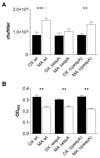Microaerobic conditions enhance type III secretion and adherence of enterohaemorrhagic Escherichia coli to polarized human intestinal epithelial cells
- PMID: 20406285
- PMCID: PMC4966633
- DOI: 10.1111/j.1462-2920.2010.02216.x
Microaerobic conditions enhance type III secretion and adherence of enterohaemorrhagic Escherichia coli to polarized human intestinal epithelial cells
Abstract
Advances in the understanding of the pathogenesis of enterohaemorrhagic Escherichia coli (EHEC) have greatly benefited from the use of human epithelial cell lines under aerobic conditions. However, in the target site of EHEC infection, the human intestine, conditions are microaerobic. In our study we used polarized human colon carcinoma cells in a vertical diffusion chamber system to investigate the influence of reduced apical oxygen levels on EHEC colonization. While apical microaerobiosis did not affect cell integrity and barrier function, numbers of adherent bacteria were significantly increased under low compared with high apical oxygen concentrations. In addition, expression and translocation of EHEC type III secreted (T3S) effector proteins was considerably enhanced under microaerobic conditions and dependent on the presence of host cells. Increased colonization was mainly mediated via EspA as adherence levels of an isogenic deletion mutant were not influenced by low oxygen levels. Other potential adherence factors (E. coli common pilus and flagella) were only minimally expressed under high and low oxygen levels. Addition of nitrate and trimethylamine N-oxide as terminal electron acceptors for anaerobic respiration failed to further increase bacterial colonization or T3S under microaerobiosis. This study indicates that EHEC T3S and colonization are enhanced by the microaerobic environment in the gut and therefore might be underestimated in conventional aerobic cell culture systems.
© 2010 Society for Applied Microbiology and Blackwell Publishing Ltd.
Figures








Similar articles
-
Intestinal adherence associated with type IV pili of enterohemorrhagic Escherichia coli O157:H7.J Clin Invest. 2007 Nov;117(11):3519-29. doi: 10.1172/JCI30727. J Clin Invest. 2007. PMID: 17948128 Free PMC article.
-
Type 2 secretion promotes enterohemorrhagic Escherichia coli adherence and intestinal colonization.Infect Immun. 2008 May;76(5):1858-65. doi: 10.1128/IAI.01688-07. Epub 2008 Mar 3. Infect Immun. 2008. PMID: 18316380 Free PMC article.
-
Enterohemorrhagic Escherichia coli pathogenesis: role of Long polar fimbriae in Peyer's patches interactions.Sci Rep. 2017 Mar 20;7:44655. doi: 10.1038/srep44655. Sci Rep. 2017. PMID: 28317910 Free PMC article.
-
A secretome view of colonisation factors in Shiga toxin-encoding Escherichia coli (STEC): from enterohaemorrhagic E. coli (EHEC) to related enteropathotypes.FEMS Microbiol Lett. 2016 Aug;363(16):fnw179. doi: 10.1093/femsle/fnw179. Epub 2016 Jul 26. FEMS Microbiol Lett. 2016. PMID: 27465489 Review.
-
Controlling injection: regulation of type III secretion in enterohaemorrhagic Escherichia coli.Trends Microbiol. 2009 Aug;17(8):361-70. doi: 10.1016/j.tim.2009.06.001. Epub 2009 Aug 5. Trends Microbiol. 2009. PMID: 19660954 Review.
Cited by
-
Shiga toxin production and translocation during microaerobic human colonic infection with Shiga toxin-producing E. coli O157:H7 and O104:H4.Cell Microbiol. 2014 Aug;16(8):1255-66. doi: 10.1111/cmi.12281. Epub 2014 Mar 21. Cell Microbiol. 2014. PMID: 24612002 Free PMC article.
-
Catabolite and Oxygen Regulation of Enterohemorrhagic Escherichia coli Virulence.mBio. 2016 Nov 22;7(6):e01852-16. doi: 10.1128/mBio.01852-16. mBio. 2016. PMID: 27879335 Free PMC article.
-
Enterohaemorrhagic Escherichia coli activates nitrate respiration to benefit from the inflammatory response for initiation of microcolony-formation.BMC Microbiol. 2020 Aug 20;20(1):261. doi: 10.1186/s12866-020-01946-w. BMC Microbiol. 2020. PMID: 32819301 Free PMC article.
-
Micromanagement in the gut: microenvironmental factors govern colon mucosal biofilm structure and functionality.NPJ Biofilms Microbiomes. 2015 Dec 16;1:15026. doi: 10.1038/npjbiofilms.2015.26. eCollection 2015. NPJ Biofilms Microbiomes. 2015. PMID: 28721237 Free PMC article. Review.
-
Pathogens' adaptation to the human host.Proc Natl Acad Sci U S A. 2018 Sep 18;115(38):9342-9343. doi: 10.1073/pnas.1813379115. Epub 2018 Sep 6. Proc Natl Acad Sci U S A. 2018. PMID: 30190426 Free PMC article. No abstract available.
References
-
- Ando H, Abe H, Sugimoto N, Tobe T. Maturation of functional type III secretion machinery by activation of anaerobic respiration in enterohaemorrhagic Escherichia coli. Microbiology. 2007;153:464–473. - PubMed
-
- Best A, La Ragione RM, Clifford D, Cooley WA, Sayers AR, Woodward MJ. A comparison of Shiga-toxin negative Escherichia coli O157 aflagellate and intimin deficient mutants in porcine in vitro and in vivo models of infection. Vet Microbiol. 2006;113:63–72. - PubMed
-
- Cottet S, Corthesy-Theulaz l, Spertini F, Corthesy B. Microaerophilic conditions permit to mimic in vitro events occurring during in vivo Helicobacter pylori infection and to identify Rho/Ras-associated proteins in cellular signaling. J Biol Chem. 2002;277:33978–33986. - PubMed
Publication types
MeSH terms
Substances
Grants and funding
LinkOut - more resources
Full Text Sources
Medical

